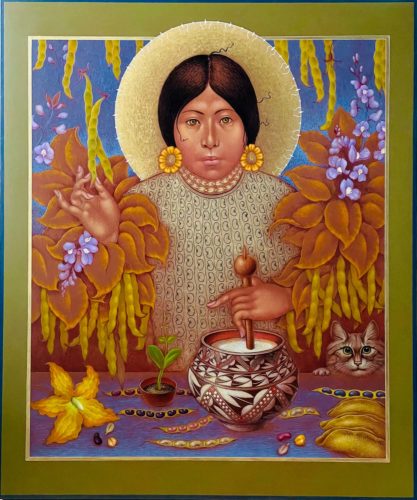
One of the most remarkable shows I’ve seen in years of writing about art wraps up this week at the Karin Clarke Gallery in Eugene.
Born in Russia, Olga Volchkova learned to paint traditional Eastern Orthodox icons — those firmly delineated, brightly colored portraits of saints, often with gold leaf halos, that are objects of veneration in the Byzantine religious tradition — in the former Soviet Union before coming to Eugene in 2000.
Her show Icons of Nature, which runs through Nov. 26 at the Clarke Gallery, represents an entirely different, perhaps fanciful faith. Instead of the saints of historical Christianity, Volchkova has used her exquisite artistry to create portraits of a new slate of saints she might like to encounter, in this life and perhaps the next. Rather than St. Francis, St. Bartholomew or St. John, she presents us with plant-based images of St. Basil, St. Peony and St. Cannabis.
Each of these plants, and others as well, are shown in the style of traditional icons, halos and all.
Some of the figures in the show haven’t quite reached canonization at the Vatican. A set of portraits personifies three food crops as three Indigenous women: Sister Bean, Sister Squash and Sister Maize. As with most of these icons, the three women stare ahead at the viewer, their expressions deadpan.
It’s the tiny details that help bring these paintings alive. Sister Maize, for example, is accompanied by a raven, which holds a single kernel of corn in its beak, and a mouse that nibbles on dry beans lying on the table in front of the saint. Next to the woman, its eyes just visible above the tabletop, a cat stares out from the picture with the same deadpan expression,
Similarly, Sister Squash shares her portrait with a butterfly on her hand and a snail crawling across the table, and Sister Bean is accompanied by the same attentive cat.
In fact, all these saints’ and sisters’ pictures are teeming with animal life: snails, ladybugs, a bear and a mountain goat, a snake, a rabbit, a hen. The gallery feels almost like a Noah’s Ark of wildlife.
What makes Volchkova’s work so compelling is the amazingly fine quality of the individual paintings. The artist paints with acrylics on birch panels that she first gessos, applying and sanding multiple layers until the surface is as smooth as a mirror. Then she sketches her images in pencil and begins the slow process of painting with fine detail. A single painting takes months, not weeks, to complete. That labor is represented in the prices for her paintings, which range from $4,000 to $12,000 — high for Eugene.
The public, though, has voted with its checkbook. Half of the 20 or so works in the show had already been sold when I visited the gallery in mid November.
Volchkova’s work has also been shown at the Jordan Schnitzer Museum of Art at the University of Oregon and at the Scheider Museum of Art at Southern Oregon University. In her current show, her icons turn the Clarke gallery into a cathedral dedicated to an expansive new religion: one that worships nature and its beauty rather than crusading soldiers of the faith. Between their delightful quirkiness and their extraordinary craftsmanship, her icons demand our careful attention.
Icons of Nature continues at the Karin Clarke Gallery, 760 Willamette Street, through Nov. 26. Hours are noon to 5:30 pm Wednesday through Friday (closed Thanksgiving Day) and 10 am. to 4 pm Saturday.